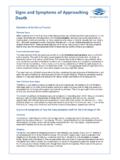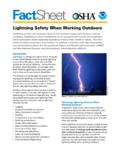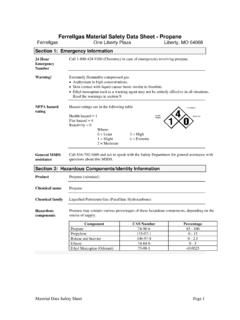Transcription of Safety Data Sheet - A&C Catalysts
1 Technicure EMI-24-CN Rev. 3. Safety data Sheet Section 1. Preparation \ Substance Identification Chemical Name of Substance: 1-(2-cyanoethyl)-2-ethyl-4-methylimidazo le Product Name: Technicure EMI-24-CN. Synonyms: 2-Ethyl-4-methyl-1H-imidazole-1-propanen itrile Details of the supplier of the Safety data Sheet ACCI Specialty Materials Telephone: (908) 474-9393 Fax: (908) 474-9388. 1600 W. Blancke Street Web: Linden, NJ 07036 USA Contact: Emergency telephone number CHEMTREC (24 hours): 1-800-424-9300. International: +001-703-527-3887. Section 2. Hazards Identification OSHA Hazards: Toxic by ingestion, Irritant GHS Classification: Toxic if ingested or inhaled Signal Word: Danger Health Environmental Physical Acute toxicity- Category 3 Acute Aquatic Toxicity- N/A Liquid, Clear Eye Corrosion- Category 2 Chronic Aquatic Toxicity- amber.
2 Respiratory Irritation- mild N/A. Skin Sensitization- Category 2. Target Organ Toxicity (Single) - Cat. 2. Aspiration Toxicity- Cat. 2. Risk Phrases: R23/24/25: Toxic by inhalation, in contact with skin, and ingestion. R36/37/38: Irritating to eyes respiratory system, and skin. Hazard Statements: H301 Toxic if swallowed. H315 Causes skin irritation. H318 Causes eye damage. H335 May cause respiratory irritation. Precautionary statements: P261 Avoid breathing dust/fumes/gas/mist/vapors/spray. P280 Wear protective gloves/eye/face protection. P301/310 IF SWALLOWED; immediately call a POISON CENTER or Physician.
3 P305+351+338 IF IN EYES; Rinse cautiously with copious amounts of tepid water for at least 15. minutes. Remove contact lenses, if present, before rinsing. Page 1 of 7. Technicure EMI-24-CN Rev. 3. Safety Phrases: S 37/39: Wear suitable gloves and eye/face protection. Hazard Overview: Toxic if ingested or inhaled. Avoid prolonged contact with this material. Overexposure may result in serious illness or death. Irritating to the skin and eyes upon contact. Inhalation causes mild to severe irritation to the lungs and respiratory tract. Inflammation to the eye is characterized by redness, watering, and itching.
4 Skin inflammation is characterized by itching, scaling, reddening, or occasionally, blistering. Potential Health Effects Eye: Causes painful eye irritation on contact. Skin: Cause skin irritation on contact Ingestion: Toxic if swallowed in excessive amounts. Inhalation: Causes severe irritation of the mucous membrane and upper respiratory tract. Carcinogenic Effects: Not available. Mutagenic Effects: Not available. Teratogenic Effects: Not available. Developmental Toxicity: Not available. Section 3. Composition Name: 1-(2-cyanoethyl)-2-ethyl-4-methylimidazo le CAS Number: 23996-25-0 : 95-96. Name: 4-methylimidazole-2-ethyl-4(5)-methyl imidazole CAS Number: 931-36-2 : 4.
5 Name: Acrylonitrile CAS Number: 107-13-1 : 500 ppm Formula: C9H13N3. Section 4. First Aid Measures Eyes: Check for and remove any contact lenses. Immediately flush eyes with plenty of water for at least 15. minutes, occasionally lifting the upper and lower eyelids. Get medical aid immediately. Skin: Immediately flush skin with plenty of soap and water for at least 15 minutes, while removing any contaminated clothing. Seek medical attention if any unusual symptoms develop Ingestion: Never give anything by mouth to an unconscious person. Induce vomiting, if conscious and alert, rinse mouth and drink 2-4 cupful's of water.
6 Examine lips and mouth to ascertain whether the tissues are damaged, a possible indication that the toxic material was ingested, the absence of such signs is not conclusive. Inhalation: Remove from exposure and move to fresh air immediately. If breathing is difficult, give oxygen. Do not use mouth-to-mouth resuscitation if victim ingested or inhaled the substance; induce artificial respiration with the aid of a pocket mask equipped with a one-way valve or other proper respiratory medical device. Notes to Physician: Treat symptomatically and supportively. Symptoms may mimic cyanide poisoning. Section 5.
7 Fire Fighting Measures Auto-Ignition Temperature: N/A. Flash Points: CLOSED CUP: 176 C (349 F). Flammable Limits: N/A. Products of Combustion: These products are carbon oxides (CO, CO2), nitrogen oxides (NO, ). Warning: Very toxic acrylonitrile gas may be produced in a fire or temperatures approaching 100 Deg C. Fire Hazards in Presence of Various Substances: Combustible in presence of open flames and Explosion Hazards in Presence of Various Substances: Risks of explosion of the product in presence of mechanical impact: Not available. Risks of explosion of the product in presence of static discharge: Not available.
8 Fire Fighting Media and Instructions: Page 2 of 7. Technicure EMI-24-CN Rev. 3. SMALL FIRE: Use DRY chemical powder. LARGE FIRE: Use water spray or fog. Cool containing vessels with water jet in order to prevent pressure build-up, autoignition or explosion. Special Remarks on Fire Hazards: Cyanide gas may be generated during any fire. During all fire fighting activities, wear appropriate protective equipment, including self-contained breathing apparatus. Special Remarks on Explosion Hazards: None Section 6. Accidental Release Measures Health and Safety Precautions: Toxic material! Personnel involved in clean-up should wear appropriate personal protective equipment (see Section 8).
9 Minimize exposure. Do not touch spilled material. Use water spray to reduce vapors. Prevent entry into sewers, basements, or confined areas. Dike material if needed. Eliminate all sources of ignition. Measures for Cleaning / Collecting: Contain the source of spill if it is safe to do so. Collect the spilled material by a method that controls vapor generation. Clean spill area thoroughly. Use appropriate tools to put the spilled liquid in a convenient waste disposal container. Finish cleaning the area by spreading soapy hot water on the contaminated surface and dispose of according to local and regional authority requirements.
10 Measures for Environmental Protections: Place waste in an appropriately labeled, sealed container for disposal. Care should be taken to avoid environmental release. Additional Consideration for Large Spills: Non-essential personnel should be evacuated from affected area. Report all emergency situations immediately. Clean up operations should only be undertaken by trained personnel This material is not regulated under RCRA or CERCLA. ( Superfund ). Section 7. Handling & Storage Handling Precautions: TOXIC, IRRITANT. Avoid open handling to skin contact. Use local exhaust ventilation or perform work under hood/fume cupboard.







